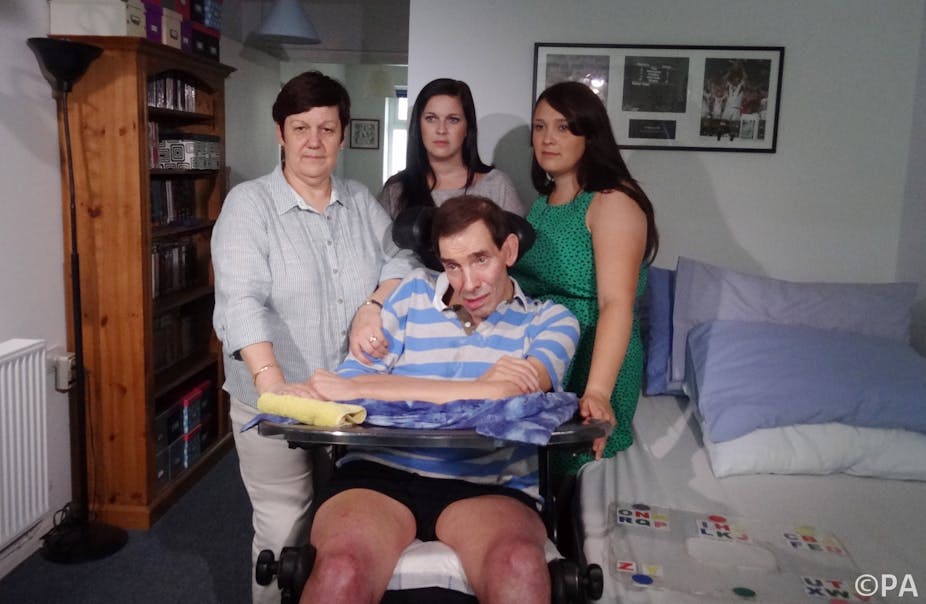Lord Falconer’s assisted dying bill would allow registered doctors to take steps to help mentally competent adult patients to end their own lives, but only in certain circumstances.
One of these circumstances is when someone is deemed to be “terminally ill”. Other forms of assisted dying, such as euthanasia, aren’t included so any law would not help people like Tony Nicklinson, who fought for the right for doctors to legally end his life after he acquired locked-in syndrome.
The bill emerged from recommendations made by the independent Commission on Assisted Dying following an extended process of public consultation and hearings. The aim of the new legislation is to regulate assisted suicide and address the “inadequate and incoherent” legal status quo in end of life care.
But the bill, unlikely to get a second reading until Parliament reconvenes in September, smacks of compromise - it is neither adequate nor coherent in its current form.
Some of the concepts put forward in the bill are poorly defined or articulated. And the distinctions made between what a doctor can and cannot do if assisting someone to die fail to differentiate appropriately between assisted suicide and other actions to end patients’ lives.
What counts as a terminal illness?
One of the clearest examples of the poor drafting revolves around the definition of a “terminal illness”. According to the bill, a person with a terminal illness is someone diagnosed as having an “inevitably progressive condition” which cannot be reversed by treatment.
While “treatment” is defined as an intervention that cannot reverse that condition, no definition of an “inevitably progressive condition” is provided. On this account, any adult with a progressive neurological condition, such as dementia or motor neurone disease, could have a terminal illness.
Ironically, while having a terminal illness, these adults might not be terminally ill. This is because being terminally ill, according to the bill, requires that an adult with a terminal illness is reasonably expected to die from that illness within six months. Presumably, those adults who are not able to obtain that reasonable expectation from their doctor can do little more than to count down the days until they come within its remit.
It is charitable to suggest that these conceptual problems show that the bill has been poorly drafted.
More troubling, concepts like “terminally ill” and “inevitably progressive condition” seem to be invoked in order to foreclose on moral distinctions and judgements that haven’t been clearly defended, and which may not stand up to scrutiny.
An arbitrary six months to live
Other than copying the standards of Oregon’s Death with Dignity Act, which allows terminally-ill Oregonians to end their lives through voluntarily self-administrating lethal drugs prescribed by a doctor, there looks to be no good reason for putting forward the “six months to live” limit.
In their final report of 2012, the commission itself suggested that new legislation should extend to those patients who will die “within the next 12 months”. Any time restriction - be it six months, 12 months or any other cut-off point - seems rather arbitrary, particularly in the light of the uncertainty about the predictability of death.
This time restriction also isn’t ethically relevant to the main arguments often used to support legislation on assisted dying. If the commission wanted, as it claimed, to support a self-determined death, there seems to be no reason why the right to self-determination should be limited only to people who are reasonably expected to die within a short period.
Nor, it might be claimed, should the law be blind to considerations about a person’s quality of life and/or suffering as criteria for allowing assistance to a person to commit suicide.
Active patient, passive doctor?
In its report, the Commission said it didn’t want “any form of euthanasia” to be permitted and emphasised the active role of a patient who needs “to be able to take the action that will cause their death”. This corresponds with the bill’s call for the passive role of the doctor who isn’t authorised “to administer a medicine … with the intention of causing [another] person’s death”.
Yet, it’s clear that doctors must take active steps to prescribe, deliver, prepare and, in some cases, assist the person to ingest the drug that will end their life.
Quite apart from the practical difficulty in separating acts of administration from acts of mere assistance, this line in the sand ensures that the legislation offers nothing for those adults like Tony Nicklinson who require more from doctors. Organisations such as the British Humanist Association have been vocal in their criticism of this position.
Rather than help, these arbitrary distinctions that limit the scope of doctors’ actions act against the core principle of ending all forms of discrimination in end of life care that formed part of the commission’s final report.
The bill needs to be clearer
As with all public engagement exercises, the process of translating a range of evidence into core principles and a draft piece of legislation has led to significant problems. Concepts are defined in ways that don’t stand up to scrutiny, and moral judgements are imposed in ways that diverge from the main reasons given to support changes in the law at the end of life.
The parliamentary process must focus on these issues and ensure that they are addressed directly.

